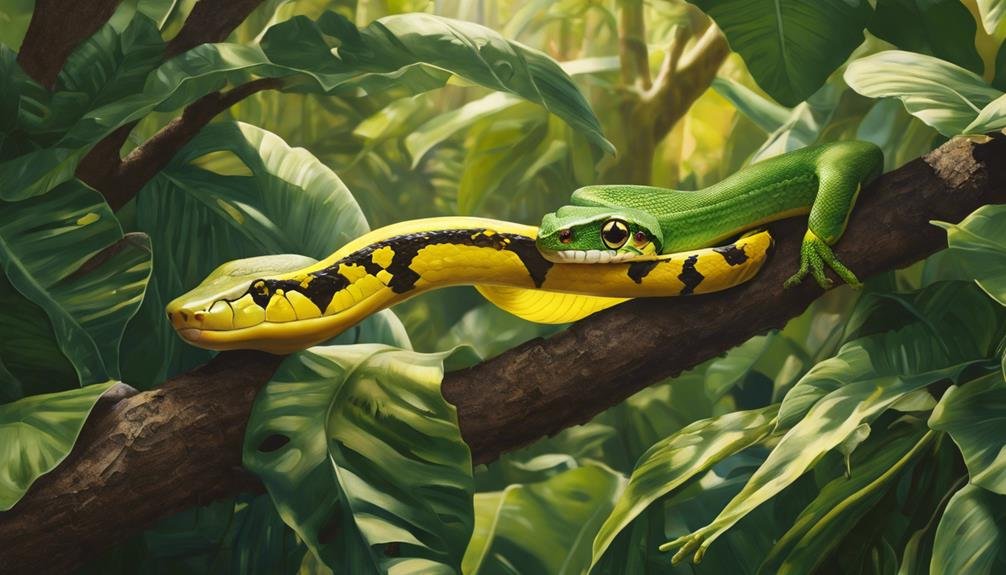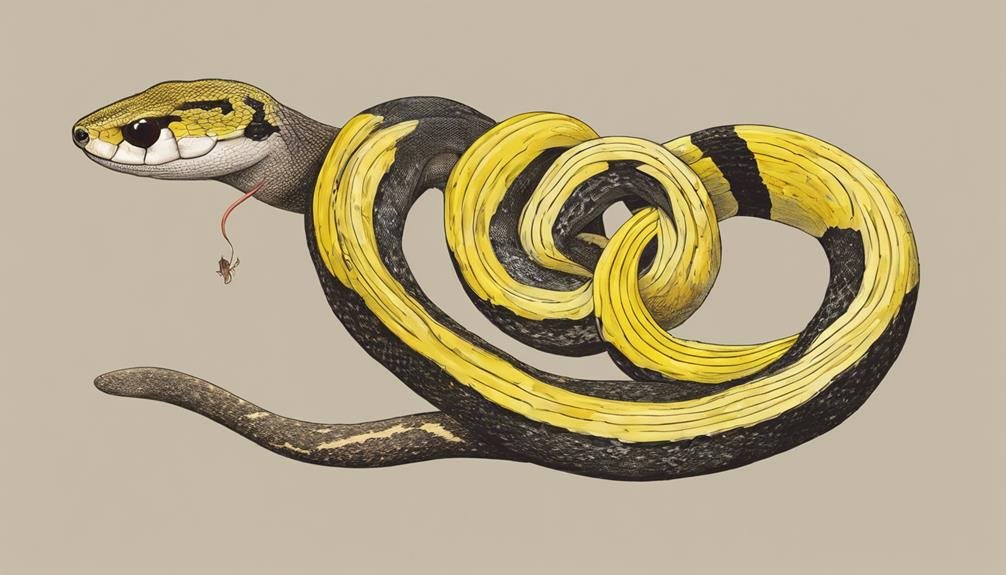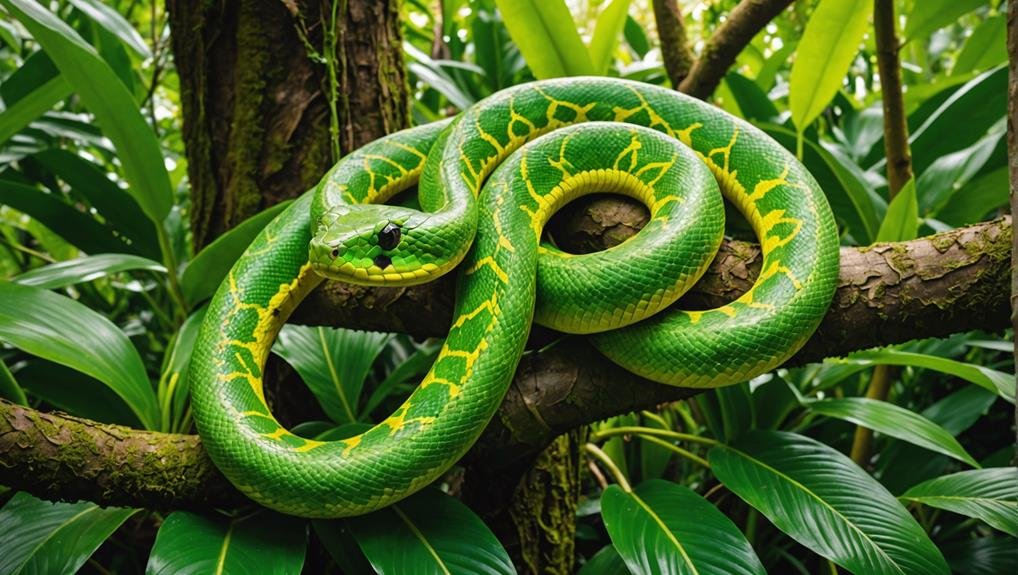When you think of a Banana Snake, you’re probably picturing its striking yellow coloration and calm demeanor. Originating from Africa, these nonvenomous constrictors have become a favorite among reptile enthusiasts due to their ease of care and alluring appearance. With over 4,000 morphs available, the genetic diversity within this species is truly intriguing. But what makes the Banana Ball Python so distinctive compared to other snakes? And how do these various morphs come about? There’s much more to uncover about their behavior, interaction, and role in conservation efforts.
Key Takeaways
- The Banana Ball Python is a nonvenomous constrictor snake with a bright yellow coloration.
- They are calm, docile, and suitable for novice and experienced snake keepers.
- Banana Ball Pythons are found in Africa, including Cameroon and Ghana.
- There are over 4,000 morphs, including unique variants like banana spider and super banana.
- Conservation efforts are crucial due to poaching and habitat loss impacting wild populations.
Banana Ball Python Overview


Regarding vibrant pet snakes, Banana Ball Pythons stand out with their bright yellow coloration and mellow personalities. As a member of the Python family, the Banana Ball Python, known scientifically as Python regius, is a nonvenomous constrictor snake. You’ll find these striking creatures primarily in Africa, particularly in countries like Cameroon and Ghana.
Despite their exotic appearance, Banana Ball Pythons are generally easy to care for, making them popular among snake enthusiasts. Their mellow temperament means they’re less likely to be aggressive, which is ideal if you’re new to keeping snakes. It’s no wonder they’ve become a favorite in the reptile community.
Interestingly, the first baby Banana Ball Python fetched a staggering $25,000, underscoring their unique appeal. While they’re now much more accessible, their beauty and calm demeanor continue to captivate many. Additionally, the IUCN Red List considers the Banana Ball Python of least concern, indicating a stable population in the wild.
Understanding these basics can help you appreciate why Banana Ball Pythons are such beloved pets. They’re visually stunning and a joy to handle and care for.
Morphs and Variants
Banana Ball Pythons are not just admired for their striking yellow color; they boast an impressive array of morphs and variants that keep enthusiasts enthralled. With over 4,000 morphs, there’s no shortage of variety. The banana spider stands out for its unique web-like pattern and vibrant banana coloration.
Imagine the excitement when the first baby banana ball python sold for $25,000. This high demand continues as breeders develop new morphs. Variants like the banana clown and super banana each bring something special to the table. For instance, super bananas lack freckles and display mesmerizing distinct color patterns.
Here’s a glimpse at some popular morphs:
| Morph Name | Unique Trait | Emotional Appeal |
|---|---|---|
| Banana Spider | Web-like pattern | Intriguingly mysterious |
| Banana Clown | High contrast coloration | Playful and vibrant |
| Super Banana | Freckle-free, clear colors | Pure and stunning |
Since their public debut in 2003, banana ball pythons have captivated the reptile world thanks to co-dominant genetic expression. Over a dozen morphs have branched off, showcasing the incredible diversity within this species. You can’t help but be amazed by these snakes’ sheer variety and beauty.
Behavior and Interaction


Regarding behavior and interaction, banana snakes, particularly the Banana Ball Python, stand out for their calm and docile nature, making them a favorite among pet owners. These snakes are rarely aggressive; instead, they exhibit defensive behaviors like curling into a tight ball when they feel threatened. This docility adds to their appeal as pets, as they’re easy to handle and rarely bite.
Banana Ball Pythons are known for their relaxed demeanor when interacting with humans. They tend to be curious but cautious, exploring their surroundings without showing signs of aggression. This makes them suitable for both novice and experienced snake keepers. Additionally, their non-venomous nature provides an extra layer of safety, especially for those new to reptile care.
In terms of breeding behavior, extensive efforts have led to various morphs of Banana Ball Pythons. These morphs aren’t only stunning but retain the high obedience that makes the species so popular. If you’re considering a pet snake, the Banana Ball Python’s unique coloration and gentle temperament make it an ideal choice.
Conservation and Threats
While Banana Ball Pythons are cherished for their calm demeanor and suitability as pets, they face significant threats in the wild. Poaching for the skin and pet trade is a major issue. These beautiful snakes are often captured and sold, which can severely impact their wild populations. Though the exact numbers of Banana Ball Pythons in the wild aren’t monitored, it’s evident that overexploitation remains a serious concern.
Habitat loss is another critical threat. In their native regions of Africa, particularly in open forests and grasslands, deforestation, and human encroachment are shrinking their natural habitats. This loss diminishes their living space and disrupts the ecosystem balance, making it harder for these snakes to find food and shelter.
Despite these challenges, Banana Ball Pythons are currently listed as the least concern on the IUCN Red List. However, this status doesn’t signify they’re safe. Continuous efforts are needed to address poaching and promote habitat conservation.
Feeding and Digestive Process


Understanding the feeding and digestive process of Ball Pythons is important for their proper care. When feeding your Ball Python, you’ll notice they use their muscular body to constrict prey, a key part of their digestion. This constriction not only subdues the prey but also initiates the process of crushing bones, making it easier to digest.
Ball Pythons prefer to consume their prey head first, usually within 5-10 minutes. This method guarantees efficient digestion, as the head-first approach allows the prey to slide down smoothly. Their unhinging jaws are fascinating, enabling them to swallow prey notably larger than their head.
To care for your Ball Python effectively, consider these key points:
- Constricting Prey: Constriction helps subdue and initiate the digestive process by crushing bones.
- Head-First Consumption: Ingesting prey head first aids in smoother digestion.
- Unhinging Jaws: Allows them to eat larger prey, ensuring they receive sufficient nutrition.
- Efficient Feeding Time: They aim to consume prey within 5-10 minutes.
- Digestive Efficiency: Proper feeding habits guarantee a healthy digestive process.
Understanding Ball Python feeding behavior is important for their care and well-being.
Conclusion
In caring for a Banana Ball Python, you’ll be charmed by its vibrant colors and gentle nature. With the vast array of morphs and variants, there’s always something new to discover. By understanding their behavior, feeding needs, and conservation status, you’ll contribute to their well-being and preservation. Whether you’re a seasoned reptile enthusiast or a curious beginner, the Banana Ball Python offers a rewarding and fascinating experience you’ll cherish.
FAQs
1. Is a Banana Snake Poisonous?
No, it’s not poisonous. Banana snakes are non-venomous constrictors. Their diet requirements include primarily rodents. Understanding their non-poisonous nature helps guarantee responsible ownership and care. You’ll find them docile and safe to handle.
2. Are Banana Snakes Good Pets?
Yes, they make great pets. Their diet is easy to manage, consisting mainly of rodents. They’re non-venomous and docile, perfect for beginners. Just make sure you understand their temperature and humidity needs for best care.
3. How Big Is a Banana Snake?
A banana snake typically grows to 3-5 feet as an adult. You can help it reach its full size potential by providing a proper banana snake habitat, including appropriate care and feeding. They’re manageable pets for many.
4. Where Do Banana Snakes Live?
You’ll find these snakes in open forests and grasslands across several African countries, such as Cameroon, Ghana, and Uganda. They prefer habitats with suitable temperature and humidity levels, which are ideal for their survival and thriving.

